" Studio Mastering Sub"
Wont be monitored at 4Kw
You realize 1000 watts RMS
is the thermal rating.
A fantasy already on its own.
"Peak" power can be udderly ignored.
Imaginary add copy data.
Might as well make up a number
I think they are wrong, its likely 6000 watts peak
and 350 watts RMS.
Or anything else anybody cares to make up
DS18 is 80 dB
The suspension is so loose
and the magnet is really really big.
And it does absolutely nothing
in the end.
Basically the suspension is so loose it explains
the 20 liter Vas
Im not trying to be snooty or negative.
And might even seem others are too.
Were just really trying to help you
not waste time.
"Blurp" bass at 55 Hz is not a subwoofer.
Its imaginary bloom bass that SPL
wars are done with.
80 dB wont win that either.
Might as well use a home HiFi 8" speaker
and call it a sub.
Heck some of those do 89 dB with 1 watt
Real manufactures have figured out thermal ratings.
So drivers dont need enclosure heatsinks.
You just put it in the box and go.
Additional thermal management is not much
more than a vent.
Wont be monitored at 4Kw
You realize 1000 watts RMS
is the thermal rating.
A fantasy already on its own.
"Peak" power can be udderly ignored.
Imaginary add copy data.
Might as well make up a number
I think they are wrong, its likely 6000 watts peak
and 350 watts RMS.
Or anything else anybody cares to make up
DS18 is 80 dB
The suspension is so loose
and the magnet is really really big.
And it does absolutely nothing
in the end.
Basically the suspension is so loose it explains
the 20 liter Vas
Im not trying to be snooty or negative.
And might even seem others are too.
Were just really trying to help you
not waste time.
"Blurp" bass at 55 Hz is not a subwoofer.
Its imaginary bloom bass that SPL
wars are done with.
80 dB wont win that either.
Might as well use a home HiFi 8" speaker
and call it a sub.
Heck some of those do 89 dB with 1 watt
Real manufactures have figured out thermal ratings.
So drivers dont need enclosure heatsinks.
You just put it in the box and go.
Additional thermal management is not much
more than a vent.
https://stereo-magazine.com/review/jl-audio-gotham-v2-review
Maybe time to stop ignoring this one in the link and working towards a much more affordable DIY like it? Explain its existence in the Hi-fi world?
The drivers and electronics are in hand, I will continue. There are is also a similar 12" from SBA to try. That will be added to the driver pool next. The JLAudio drivers from the Gotham are always there to try. My Volcano cabs use the 12W7 driver as a reference, to hit that mark with a more affordable driver
Please understand that 4kw refers to dual opposed. 2kw per driver. It's actually similar to the Gotham, those are dynamic power ratings. Actual Wrms per voice coil is 600wrms with my mono class D amp modules, and we are talking about 4x coils in a dual opposed setup. Please at least try to understand the situation first. Maybe starting with the fact that the concept box volumes are adjustable up or down
In a recent discussion, I ran one of the Dayton HO 12" in these cab sims, and they model pretty similar. Please explain? The DS18 drivers actually appear to not be measured after breaking in. According to their tech, this is getting corrected right now. But who cares, I cant fathom why messing around bothers you so much?
I have a pair of woofers from sealed boxes that are frozen in place. Heat dissipation in sealed high power boxes should be managed. You are incorrect, there is a loss of output followed by driver failure
Maybe time to stop ignoring this one in the link and working towards a much more affordable DIY like it? Explain its existence in the Hi-fi world?
The drivers and electronics are in hand, I will continue. There are is also a similar 12" from SBA to try. That will be added to the driver pool next. The JLAudio drivers from the Gotham are always there to try. My Volcano cabs use the 12W7 driver as a reference, to hit that mark with a more affordable driver
Please understand that 4kw refers to dual opposed. 2kw per driver. It's actually similar to the Gotham, those are dynamic power ratings. Actual Wrms per voice coil is 600wrms with my mono class D amp modules, and we are talking about 4x coils in a dual opposed setup. Please at least try to understand the situation first. Maybe starting with the fact that the concept box volumes are adjustable up or down
In a recent discussion, I ran one of the Dayton HO 12" in these cab sims, and they model pretty similar. Please explain? The DS18 drivers actually appear to not be measured after breaking in. According to their tech, this is getting corrected right now. But who cares, I cant fathom why messing around bothers you so much?
I have a pair of woofers from sealed boxes that are frozen in place. Heat dissipation in sealed high power boxes should be managed. You are incorrect, there is a loss of output followed by driver failure
The Gotham appears to have a little more than 19 liters of volume.
Yes
Conventional design, looks like woven fiber for mid bass.
This is good performance for low price point.
Manufacture doesn't need expensive pulp production.
Just molds and epoxy.
Dayton and likely 20 or more manufactures to source these.
for Diy.
The HiVi tweeter pod 90's thing basically 20 bucks these days
least it makes some sense for the 4000 watt rating now.
Actual continuous is 1/8th of that
600 watts mildly then feasible.
Since 85 to 95 dB listening levels
should be way way way under that
Mechanically a speaker is what it is.
Not much to concept with.
With a spreedsheet and well known formulas.
Aka simulator with pretty graphs to confuse people
to imagine more bass.
You hit auto calculate using known alignments
and get a volume for hopefully .7 to .8 Q
port is tuned around Fs above or below 3 to 6 Hz
and all done.
If the alignment starts climbing 10 or more Hz higher than Fs
or you spend 20 years fiddling with the model for " more bass"
Toss the driver in the reject bin.
Generic " Car Sub" 12" is gonna be same old 1.6 to 2 cubic feet.
45 to 55 liters. Mechanically it is looooose suspension.
Why efficiency is usually poor to average.
Basically means the Vas should be close to that.
And if widely different like 19 liters like the DS18
pretty big warning sign.
Yes
Conventional design, looks like woven fiber for mid bass.
This is good performance for low price point.
Manufacture doesn't need expensive pulp production.
Just molds and epoxy.
Dayton and likely 20 or more manufactures to source these.
for Diy.
The HiVi tweeter pod 90's thing basically 20 bucks these days
least it makes some sense for the 4000 watt rating now.
Actual continuous is 1/8th of that
600 watts mildly then feasible.
Since 85 to 95 dB listening levels
should be way way way under that
Mechanically a speaker is what it is.
Not much to concept with.
With a spreedsheet and well known formulas.
Aka simulator with pretty graphs to confuse people
to imagine more bass.
You hit auto calculate using known alignments
and get a volume for hopefully .7 to .8 Q
port is tuned around Fs above or below 3 to 6 Hz
and all done.
If the alignment starts climbing 10 or more Hz higher than Fs
or you spend 20 years fiddling with the model for " more bass"
Toss the driver in the reject bin.
Generic " Car Sub" 12" is gonna be same old 1.6 to 2 cubic feet.
45 to 55 liters. Mechanically it is looooose suspension.
Why efficiency is usually poor to average.
Basically means the Vas should be close to that.
And if widely different like 19 liters like the DS18
pretty big warning sign.
Last edited:
Doesn't make sense. Wouldn't lose suspension mean usually higher efficiency? The ZXI cone is a lot hard to move with hands then most other drivers I have ever felt, and I have had my hands on lotsMechanically it is looooose suspension.
Why efficiency is usually poor to average.
According to techs and installers, this driver needs more like actual 2kw dynamic on it and minimum 1kwrms to be really happy. Are you only considering traditional old school woofers and boxes and small amps and not considering controlling the cone with amplifier power and stiff suspension? This thing can be barely moved much like the Sunfire drivers but can move cleanly a lot further than most other drivers under a lot of power and power is a lot more affordable than cab size
Is it possible that these types of drivers work in a different power range to T/S work with? Maybe they are too stiff to measure at usual standards. Why so much against just putting them in some likely boxes and having a listen and measure with a mic at more realistic powers? Your experience and insight make the different between a successful and unsuccessful test. This is what makes it difficult to fathom the prevailing attitude of shouting down experimenting with different concepts
Is it possible that these types of drivers work in a different power range to T/S work with? Maybe they are too stiff to measure at usual standards. Why so much against just putting them in some likely boxes and having a listen and measure with a mic at more realistic powers? Your experience and insight make the different between a successful and unsuccessful test. This is what makes it difficult to fathom the prevailing attitude of shouting down experimenting with different concepts
I should make the point that the concept cabs are based around power amp modules from Erica.C. These feature integrated PSU. Seem to be regarded well by forum members. I have a number of them and will be ordering 8x of the hardened 600wrms mono modules for my 4x DJ subs. These have DVC. Two more of those modules for the Volcano instrument amp cab concept and 4 more for the mastering sub. Will over them in pairs over time, but I think they will be worth it
Targeting the performance of stereo Gothams (one pair) in my mini DJ sound system based around 4x Volcano subs. I can save up and eventually get 4x 13W7 drivers that are in the Gotham. It would take me at least 2 years to save that. I can't understand why continuing to work with the DS18 driver on hand is a bad thing if they actually turn out to sound as musical?
Should I take this to understand that you guys have actually heard the W7 and ZXI drivers, and it's all first-hand knowledge in your advice to stop?
Should I take this to understand that you guys have actually heard the W7 and ZXI drivers, and it's all first-hand knowledge in your advice to stop?
Must admit, not really sure how to set it to measure coil Re properly.
Use the lowest resistance range above the resistance you are measuring for the most accuracy.
Air movement and sound can affect the resistance readings a bit, if you note fluctuations, they may be the cause.
Check the leads together, any series resistance they have needs to be subtracted from the reading.
Clean the leads if they have more than 1/10th ohm resistance.
By the time a heavy magnet structure has heated up, the voice coil may be roasted.Art, any comments of the TF radiator for use in sealed and PR designs?
Most of the driver's heat transfer is from it's vent. I'd suggest absorption fins in that area of the "TF radiator" .
Putting the exterior radiator on the rear of the cabinet would be a more direct heat transfer path than side wings.
Increasing the exterior radiator surface area with fins would increase heat transfer and be a more efficient use of the alloy material.
A black finish of the heat sink would increase it's heat transfer.
Once you post outdoor measurements of a woofer's response in a cabinet I'll give you an opinion as to it's suitability.The TF radiator in the air-con home studio is in hopes to use DSP to flatten to 16Hz. Looking for your opinion on suitability of such a device as a studio mastering sub if the driver tests well for a smooth response with the 116dB to 120dB that I am expecting with 4Kw
I don't recall the Xmax of the driver you are using, but I wouldn't expect any sealed 12" to do much more than ~102 dB clean at 16Hz.
120dB at 20Hz would require almost 24 inch (two feet) peak to peak excursion from a 12" driver, that won't happen with any amount of power.
Art
Art, fins and a second drain panel can be applied under the standoffs too. That's a good idea and I will add that in. How do you see the magnet building any heat when there is such a soak on it?
A sink on the back will defeat the dual opposed, but a second panel inside the back separated by the standoffs will still be connected to the sides and to the top by fins. It will still face the vent output at 10mm away. I can redraw the standoffs as a radiating pattern fins
A sink on the back will defeat the dual opposed, but a second panel inside the back separated by the standoffs will still be connected to the sides and to the top by fins. It will still face the vent output at 10mm away. I can redraw the standoffs as a radiating pattern fins
Are you dropping the understanding that you folks brought me to that F3 30Hz and F10 20Hz is flat? I still have the model of the F3 16Hz model if you think that kind of tune is more suitable now120dB at 20Hz would require almost 24 inch (two feet) peak to peak excursion from a 12" driver, that won't happen with any amount of power.
An infrared thermometer makes it possible to see heat buildup.How do you see the magnet building any heat when there is such a soak on it?
The heat making it to the outside of the slab magnet has traveled through a chunk of ceramic.
Ceramic does not conduct heat very well compared to aluminum.
I understand flat is flat, a straight line on a frequency response graph.Are you dropping the understanding that you folks brought me to that F3 30Hz and F10 20Hz is flat?
F3 is -3dB below flat, F10 is -10dB below flat.
At 20Hz, a drop in level of -4dB sounds around half as loud.
Art, alloy is more conductive. If ceramic is showing heat, it's radiating and straight in the alloy. Ceramic won't build heat up to failure levels before showing. My 50lb brushed electric disposes magnet heat through the jacket and attached foil. If ceramic couldn't dump heat as you say, then the motor will cook, but the radiator actually works well enough to keep WOT
The define thread was steered away from the flat to 16Hz devices that I was simming up with things like getting sick and such from yourself and others. I don't mind going back to the flat to 16Hz definition and insist in return that if it can't do F3 16Hz then its not a subwoofer
The define thread was steered away from the flat to 16Hz devices that I was simming up with things like getting sick and such from yourself and others. I don't mind going back to the flat to 16Hz definition and insist in return that if it can't do F3 16Hz then its not a subwoofer
We should note yet again the strong point of the concept cabs. The air volumes are variable. This means that tuning is also variable to suit the driver
Now working with high excursion/very high power/very low Vas drivers presents a challenge with Bass Reflex due to the small air chamber and very long port. Next is a breaker box concept for these kinds of drivers in bass reflex. This has been modelled in Hornresp as a non offset TL instead of the BR wizard. Reason is the TL model allows messing with fill, which I can't figure out how to do in BR wizard. Again, in TL mode, I can add flares to the port which I also cant figure out how to do in Hr
Breaker box is for breaking the driver in while doing a proof of concept at the same time. The breaker boxes will be a very basic layout with unfolded piles and such for the TL concepts and without the fancy work for the BR concept
So two breaker boxes to break the drivers in. One TL and one BR
Now working with high excursion/very high power/very low Vas drivers presents a challenge with Bass Reflex due to the small air chamber and very long port. Next is a breaker box concept for these kinds of drivers in bass reflex. This has been modelled in Hornresp as a non offset TL instead of the BR wizard. Reason is the TL model allows messing with fill, which I can't figure out how to do in BR wizard. Again, in TL mode, I can add flares to the port which I also cant figure out how to do in Hr
Breaker box is for breaking the driver in while doing a proof of concept at the same time. The breaker boxes will be a very basic layout with unfolded piles and such for the TL concepts and without the fancy work for the BR concept
So two breaker boxes to break the drivers in. One TL and one BR
Art, your comments, hits the spot. I have been thinking about how to implement it. An alloy back panel makes sense for a single driver and dual opposed can fire onto a common plate, but that would be trapped in the middle of the box. It would need to tap into new alloy side panels. Basically for dual opposed it would look like 'H' with the alloy sides and the now internal panel that is normally a back panel with a singe driver. Does this mek sense?Most of the driver's heat transfer is from it's vent. I'd suggest absorption fins in that area of the "TF radiator" .
Putting the exterior radiator on the rear of the cabinet would be a more direct heat transfer path than side wings.
An active sub can do even better with fan power supply available within the chassis. A 200mm flat bar can replace the back panel and a 80x80mm box section on that and through the box would mount a fan to cool that pipe, bar and collar combo
The Volcano TLS with the reversed driver has the motor in free air, and if suspension noise turns out to be a non issue, then I can't see a better option for a high power sealed dual opposed setup. The top segment of the TLS can be set up instead of flat to increase cab height, and such a pair could make a pretty different looking speaker stands. It's sealed, the volume can be increased to suit any driver that fits the flat round baffle area
The sealed and BR concepts are out of the way for the very high excursion, low Vas, high power drivers. I just realised that description describes which long arms of the law is getting twisted. We need a better name for these crop of drivers. I think currently the best description would be Pro Mobile, which is where these got developed and are built just as tough if not tougher than PA drivers. I am using DS18 PRO-ZT69s for the tops. These are also pro mobile drivers and very high efficiency and power
In running sim after sim, I found that Vb to port ratio issues of BR is best sorted out as a TL in HR. So thousands of sims going every which way to the realisation of a very clean TL design going low, a TH version of that TL going a bit higher but not as low. And a louder 40Hz version. All slim and tall to 800mm with scoopy flared ports. Will make fine stands for the tops for my system if they work out well in testing
But for testing, I have prepared a TL with the same pipe but different folding into a shorter box that I can use to break the driver in the car. As well as another TL design breaker box. This one is a more conventional 3 segment type that encloses the driver in a slim 800mm tower. If either of these two tests boxes work out, I'll go on to turn that into a 2.1 channels instrument amp. I have carefully engineered the layout to expand to the potent portable shape that I have in mind. These two designs are live and buildable if anyone is interested in trying out pro mobile subs for home or Dancehall reggae/dub/eDub
The main drive to develop the 4x subwoofer based Volcano sound system is to derive a micro-DJ system carried on the roof racks that doubles as home HT when not working and very very small but potent and bass heavy. As well as a single stereo capable portable and a home studio mastering sub. Weight is not an issue. Neither is amp power. Size is paramount while maintaining a high output and extended low range
Unless anyone can pick flaws in these two breaker/portable concepts and HR model, these are ready to cut and assemble. I only have 1kw on hand to test the amp. Will order 2.8kw soon after trying to pay for this DATSv3 that would make dealings with these things much easier
First up Volcano TLAmp1
This is 12mm MDF that will be laminated and deadened with what I call 'drop stitch brace'. This is for narrow stuff where internal space is critical. What I do is laminate the internal sides of the panels first. Then stack them up and lined, drill through them all over randomly. During construction, I run dowels through the cab depth and glue them in. Cleaned up and sanded from the outside and laminate over. The drop stitches takes care of low frequency and the skins prevent higher frequency vibrations
The TLAmp1 is 700cm tall and 450mm wide and 400mm deep. This forms the footprint and total height of a portable, carrying 1.2kwrms initially for the sub section and 600wrms for a pair of built-in tops. First fitted into the car just as a sub to break in the ZXI12.4D and ZR12.4D drivers
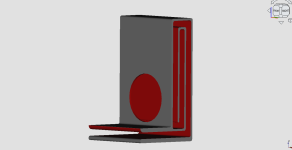
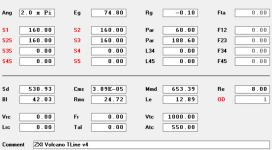
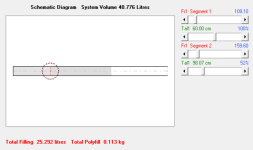
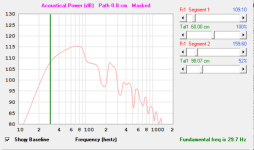
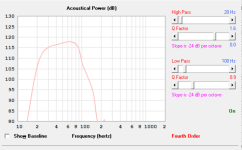
Volcano TLAmp2
In 16mm MDF. This one keeps the driver in, but I can expand it to instrument amp width if it goes well. Otherwise, might look ok just as a sub too. The TL is more traditional but configured to suit the pro mobile type of driver
Height 800mm, width 321mm, depth 376mm
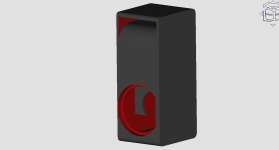
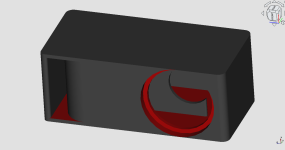
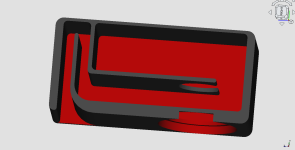
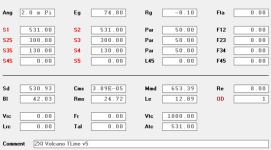
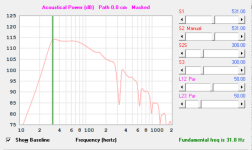
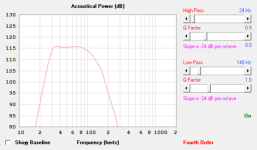
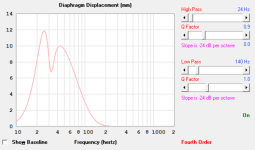
Will edit the original post to include these two breakers
@GM, @weltersys, @Booger weldz Guys, she is up. This is where I ended up for something to try the drivers out in. Do they look workable?
In running sim after sim, I found that Vb to port ratio issues of BR is best sorted out as a TL in HR. So thousands of sims going every which way to the realisation of a very clean TL design going low, a TH version of that TL going a bit higher but not as low. And a louder 40Hz version. All slim and tall to 800mm with scoopy flared ports. Will make fine stands for the tops for my system if they work out well in testing
But for testing, I have prepared a TL with the same pipe but different folding into a shorter box that I can use to break the driver in the car. As well as another TL design breaker box. This one is a more conventional 3 segment type that encloses the driver in a slim 800mm tower. If either of these two tests boxes work out, I'll go on to turn that into a 2.1 channels instrument amp. I have carefully engineered the layout to expand to the potent portable shape that I have in mind. These two designs are live and buildable if anyone is interested in trying out pro mobile subs for home or Dancehall reggae/dub/eDub
The main drive to develop the 4x subwoofer based Volcano sound system is to derive a micro-DJ system carried on the roof racks that doubles as home HT when not working and very very small but potent and bass heavy. As well as a single stereo capable portable and a home studio mastering sub. Weight is not an issue. Neither is amp power. Size is paramount while maintaining a high output and extended low range
Unless anyone can pick flaws in these two breaker/portable concepts and HR model, these are ready to cut and assemble. I only have 1kw on hand to test the amp. Will order 2.8kw soon after trying to pay for this DATSv3 that would make dealings with these things much easier
First up Volcano TLAmp1
This is 12mm MDF that will be laminated and deadened with what I call 'drop stitch brace'. This is for narrow stuff where internal space is critical. What I do is laminate the internal sides of the panels first. Then stack them up and lined, drill through them all over randomly. During construction, I run dowels through the cab depth and glue them in. Cleaned up and sanded from the outside and laminate over. The drop stitches takes care of low frequency and the skins prevent higher frequency vibrations
The TLAmp1 is 700cm tall and 450mm wide and 400mm deep. This forms the footprint and total height of a portable, carrying 1.2kwrms initially for the sub section and 600wrms for a pair of built-in tops. First fitted into the car just as a sub to break in the ZXI12.4D and ZR12.4D drivers





Volcano TLAmp2
In 16mm MDF. This one keeps the driver in, but I can expand it to instrument amp width if it goes well. Otherwise, might look ok just as a sub too. The TL is more traditional but configured to suit the pro mobile type of driver
Height 800mm, width 321mm, depth 376mm







Will edit the original post to include these two breakers
@GM, @weltersys, @Booger weldz Guys, she is up. This is where I ended up for something to try the drivers out in. Do they look workable?
Remembered to pick up a battery today. The ZXI12.4D measures exactly 4R on each coil. I checked the other DS18 drivers here, 8 in total, and they all measure Re to spec. Will order a DATSv3 tomorrowUse your multimeter.
CAD work over for now except to loft the panels and cut. That's for tomorrow. Today I finally get the chance to interfere with the new refurb laptop and the Thunderbolt 4 hub with quad monitor support
TLAmp1 vs 2
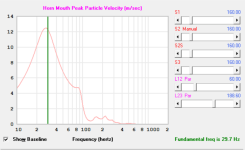
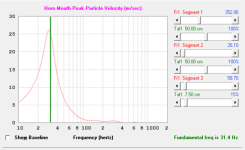
Hope it means something. To me, it's just numbers until I hear how it sounds. No context to refer, have never heard a port chuff with music
I think I might make a 30L box too and fit it with a 40 or 60mm dia undersize port to keep length manageable. Will be good to gain some experience with this


Hope it means something. To me, it's just numbers until I hear how it sounds. No context to refer, have never heard a port chuff with music
I think I might make a 30L box too and fit it with a 40 or 60mm dia undersize port to keep length manageable. Will be good to gain some experience with this
- Home
- Loudspeakers
- Subwoofers
- Volcano Subwoofer Cabs, design and build